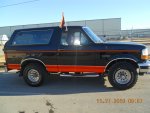yo D,
DTC 63 Throttle Position Sensor (TPS) voltage too low.
Bad or misadjusted TPS,
TB base idle mis-set,
binding throttle cable
Suspect open TP sensor, or wiring/harness issues such as connector/terminal corrosion, etc.
Test by Ryan M
slow to load
for following, use this diagram by beetlejuice[/url];
TPS is on right side, about middle of page

&
Connector Pin Outs, Bronco & Ford Truck in 85-95

Source: by Steve83 (Steve, That dirty old truck) at SuperMotors.net
Key off.
l TP sensor disconnected.
Key on, engine off.
Measure voltage between VREF circuit and SIG RTN circuit at the TP sensor vehicle harness connector.
Is voltage between 4.0 and 6.0 volts?
Yes, REPLACE TP sensor. RERUN Quick Test.
No, Key off. RECONNECT all components. GO to Pinpoint Test Step C1.
C1 CHECK VEHICLE BATTERY POWER CIRCUIT;
Key off.
Disconnect Powertrain Control Module (PCM).
Inspect for damaged or pushed out pins, corrosion, loose wires, etc. Service as necessary.
Install breakout box and connect PCM to breakout box.
breakout box test pins numbers are same as EEC's pin numbers:
Key on, engine off.
Measure voltage between Test Pin 37 at the breakout box and SIG RTN circuit in the Data Link Connector (DLC).
Note voltage.
Measure voltage across battery terminals.
Note voltage. Are both voltages greater than 10.5 volts, and are both voltages within 1.0 volt of each other?
Yes, GO to C2.
No Key Off, RECONNECT sensor (if applicable).
GO to B1.
I don't have the B2 nor C2, yet.
so,
A NON-Ford NEW TPS failure is sad to say, a common nuisance; I had a new switch fall apart in my hands recently, as well as other crapola parts from CH...
Also TSB 89-14-07 TPS Screws
Publication Date: JULY 14, 1989
FORD: 1983-89 CROWN VICTORIA, MUSTANG, TEMPO, THUNDERBIRD
1984-89 ******
1986-89 TAURUS
LINCOLN-MERCURY: 1983-89 CONTINENTAL, COUGAR, GRAND MARQUIS, MARK VII, TOPAZ, TOWN CAR
1984-87 LYNX
MERKUR: 1985-89 ALL MERKUR LINES
LIGHT TRUCK: 1983-89 ALL LIGHT TRUCK LINES
ISSUE: All Throttle Position Sensor (TPS) mounting screws have a "Pozidrive" head. The "Pozidrive" head looks a lot like a Phillips ***** head. Use of a Phillips head screwdriver to remove a "Pozidrive" ***** will normally result in a rounded or damaged ***** head. Many technicians think it is an overtorqued or "frozen" *****. An adhesive was also used as a thread sealant starting with the 1988 model year. This adhesive requires still more effort to loosen and remove the *****.
ACTION: To prevent rounded or damaged ***** heads when servicing the TPS mounting screws, technicians should always use a #2 "Pozidrive" screwdriver.





